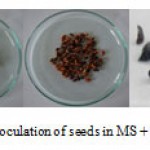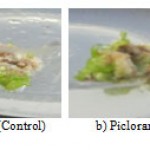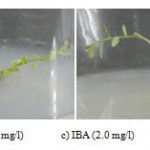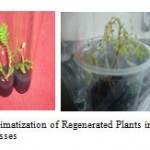Manuscript accepted on : 29 February 2012
Published online on: --
Indirect Somatic Embryogenesis in Emblica : A Preliminary Study in our Research Lab
Preeti Madharia and Amit Kumar Dutta
Department of Biotechnology, Rungta College of Science and Technology (Affiliated Pt. Ravishankar Shukla University, Raipur), Durg (CG). India.
ABSTRACT: Emblica, common name Amla, are widely used in the Indian system of medicine and believed to increase defense against diseases. Different activities of Amla are today well known and famous for all persons as well as for all researchers. Seeds and different seedling parts were used as explants. These explants were surface sterilized and Seedling parts were induced on Murashige & Skoog's (MS) liquid medium with hormone. The seedling part of Emblica was further subculture on MS with different hormone concentration. The in vitro generated callus with shoot initiation was rooted on rooting media with different concentration of hormone. By this method 60% shoots were rooted. Only 46% shoots were rooted within 2-3 weeks in this method. The in vitro rooted plants could be acclimatized and hardened in green house and transplanted to the field successfully. This experiment will help in the large scale plant production of Emblica. Further long term study is required to get final conclusion.
KEYWORDS: Emblica; Diseases; Indian System of Medicine
Download this article as:| Copy the following to cite this article: Madharia P, Dutta A. K. Indirect Somatic Embryogenesis in Emblica : A Preliminary Study in our Research Lab. Biosci Biotech Res Asia 2012;9(1) |
| Copy the following to cite this URL: Madharia P, Dutta A. K. Indirect Somatic Embryogenesis in Emblica : A Preliminary Study in our Research Lab. Biosci Biotech Res Asia 2012;9(1). Available from: https://www.biotech-asia.org/?p=9644 |
Introduction
Amla (Indian Gooseberry) or Anola is known for its medicinal and nutritional values since long and it is used in various forms. Amla is the richest source of vitamin C among all fruits after Barbados Cherry.1 It is considered to be one of the strongest rejuvenatives. With increasing awareness about being healthy and shift towards ayurvedic and herbal medicines, amla products are being consumed in large quantity. It has application as antioxidant, immunomodulatory, antipyretic, analgesic, cytoprotective, antitussive and gastroprotective2. It is also useful in memory enhancing, ophthalmic disorders and lowering cholesterol level. It is also helpful in neutralizing snake venom and as an antimicrobial. Indigenous to India, amla is primarily grown for cultivation in Uttar Pradesh, and can also be found growing wild at the foothills of the Himalayas and in parts of South India. Amla from Benares is generally considered the best in India. Emblica is propagated by vegetative means, which is a difficult and slow process. In recent years, tissue culture techniques are increasingly being used for multiplication of several economic plants and, therefore tissue culture would be useful for multiplication of this tree too. Its mineral and vitamin contents include calcium, phosphorous, iron, carotene, thiamine, riboflavin, and niacin. The seeds of the Indian gooseberry contain a fixed oil, phosphatides, and an essential oil.3 The fruits, bark, and the leaves of this tree are rich in tannin. The fruits, leaves and bark are rich in tannins. The root contains ellagic acid and lupeol and bark contains leucodelphinidin. The seeds yield a fixed oil (16%) which is brownish-yellow in colour. It has the following fatty acids: linolenic (8.8%), linoleic (44.0%), oleic (28.4%), stearic (2.15%), palmitic (3.0%) and myristic (1.0%). The low molecular weight hydrolyzable tannins (<1,000), namely Emblica nin A and Emblica nin B, along with pedunculagin and punigluconin are the key ingredients in Emblica.,1,4.
Materials and Methods
The explants used for culture were seed and callus induced from different seedling parts(Fig No.1, 2 & 3). Only analytical reagents grade (Analar) chemicals and corning or borosil glassware was used. For culture, the seeds of Emblica officinalis were washed with running tap water. Surface sterilized with 1 percent fungicide (Bavistin) for half an hour and separate stock solutions were prepared for continuing our experiment.
 |
Figure 1, 2, 3: Inoculation of seeds in MS + GA3.
|
Results
Responses of seeds after 1 week
After repeated washing in sterile distilled water the seeds were aseptically inoculated in the ms medium containing growth adjuvants individually and in a few combinations(Fig 3).
Responses of Callus after 2 weeks
The explants first showed swellings at cut end within 4-5 days of inoculation and after one week the swollen portion busted out to release undifferentiated callus mass. The callus initiated from the seedling parts in respective media with growth hormones are shown in the figures 4 (Callus induction in MS + different growth regulators)
 |
Figure 4: a)MS (Control) b) Picloram (0.5 mg/l).
|
Responses of shoots for rooting after 4 week
The shoot initiated from the callus in respective media with growth hormones are shown in the figures 5.
 |
Figure 5:
|
5a) IBA (0.5 mg/l) b) IBA (1.0 mg/l) c) IBA (2.0 mg/l) d) MS (Control)
According to the above photographs, observation table has been shown below:
| S.No. | Media composition | Result |
| 1. | MS | Shoot is green, old leaves are falling and new leaves are coming. |
| 2. | IBA(0.5) | Leaves are coming, twice growth of shoot. |
| 3. | IBA(1.0) | Shoot is green, leaves fallen and from fallen leaves callus induction. |
| 4. | IBA(1.0) | Older leaves are fallen and from fallen leaves callus induction, new leaves are coming. |
| 5. | IBA(2.0) | Root induction and older leaves are fallen. |
| 6. | IBA(2.0) | Older leaves are fallen and from fallen leaves callus induction, new leaves are coming. |
| 7. | IAA(1.0) | Shoot- Browning and no growth. Root- root induction. |
| 8. | IAA(2.0) | Shoot- Browning and no growth. Root- root induction. |
| 9. | NAA(1.0) | Older leaves are fallen and from fallen leaves callus induction, new leaves are coming. |
| 10. | NAA(1.0) | Roots are coming and plant growth twice. |
| 12. | NAA(2.0) | Browning of shoot and small roots are coming. |
| 13. | BAP(2.0)+IBA(0.5) | Browning of shoot and no growth. |
 |
Figure 6: Acclimatization of Regenerated Plants in Disposal Plastic Glasses.
|
Discussions
Sterilization is must for the seeds prior to inoculation in order to avoid the contamination. Many Scientists studied the negative effect of 2,4-Diclorophenoxy acetic acid (2,4-D) on seed germination of the Euphorbia esula. In Givotia rottleriformis Rambabu et al., (2005) studied the effect of Gibberellic acid (GA3) on enhancement of in vivo seed germination5. Our work also similar to the above workers and we also reported high frequency shoot regeneration from shoot tip, nodal and internodal segments of Phyllanthus amarus and studied the effect of different concentrations of BAP, Kn and coconut milk on shoot tips, axillary and internodal segments. Hardening was done in the liquid MS medium and the survival rate of the acclimatized plants was 85%. As first step in many tissue culture experiments, it is necessary to induce callus from the primary explant, It can be obtained from a tissue fragment and only some of the callus cells exhibit the totipotency, i.e. the ability to differentiate into tissues, organs and even embryos, being able to regenerate whole plants.6-8
Conclusion
The present investigation entitled “Indirect Somatic Embryogenesis In Emblica: A Preliminary Study in our Research Lab”. For culture, the seeds of Emblica officinalis were washed with running tap water. surface sterilized with 1 percent fungicide (Bavistin) for half an hour. Explant were washed twice with sterilized distilled water and add tween-20 (mild detergent) 2-3 drops for 10 minutes then again washed twice with sterilized distilled water. Washed with 70% alcohol (ethyl alcohol) for 5 minutes then treated with sodium chloride for 10 minutes and mercuric chloride for 5 min. By this procedure maximum seed germination takes place. MS media with GA3 shows maximum success per cent of 87.50% was recorded. After one week the swollen portion busted out to release undifferentiated callus mass. Success per cent of callus induction, shoot and root initiation in MS + Picloram (1.0 mg/L) and MS + BAP (1.0 mg/L) 72.88% was observed. All concentrations of IBA, IAA and NAA used individually for in vitro rooting of shoots of Emblica officinalis and show 70.02% successful result. However, combinations of IBA (2.0 mg/l) and BAP (2.0 mg/l) have failed to induce rooting. For acclimatization sterile cocopeat and fungicide (bavistin) 0.01 gm in 100 ml is prepared with 1/8 media (with stock solutions). Kept in autoclaved disposal plastic glass and sterilized polythene. Transferred the regenerated plant in these disposal glasses and placed in tissue culture lab for 1-2 weeks. Then transfer it into poly-house and green house.
Acknowledgement
We are really thankful to Hon,ble Shri Sanjay Rungta, Chairman & Director Saket Rungta for their help & support. I owe my deep gratitude to Prof. G. D Sao & Prof. A. Vani for their time to time guidance throughout this project. We are really thankful to our Parents for their better cooperation throughout our career.
References
- Bhattacharya, A., Chatterjee, A., Ghosal, S., Bhattacharya, S. K. Antioxidant activity of active tannoid principles of Emblica officinalis (amla). Indian Journal Experimental Biology; 37(7): 676-80(1999).
- Bhattacharyya, R., Bhattacharya, S. High frequency in vitro propagation of Phyllanthus amarus & Thonn. by shoot tip culture. Indian Journal Experimental Biology, 39:1184-1187(2001).
- Calixto, J. B., Santos, A. R. S., Filho, C. V., Yunes R. A. A review of the plants and root culture of Phyllanthus urinaria (Euphorbiaceae): Plant Cell Tissue and Organ Culture, Indian Journal Experimental Biology, 70: 301-309(1998).
- Dhankhar, G.S., Singh, M. Seed germination and seedling growth in amla (Phyllanthus emblica ) as influenced by GA3 and Thiourea. Crop Research, 12(3): 363-366(1996).
- Ghanti, K. S., Govindaraju, B., Venugopal, R. B., Rao, S. R., Kaviraj, C. P., Jabeen, F. T. Z., Barad, A., Rao, S. High frequency shoot regeneration from Phyllanthus amarus & Thonn. Indian Journal Biotechnology, 3:103-107(2004).
- Khanna, P., Bansal, R. Phyllantidine and phyllantine from Emblica officinalis Gaertn leafs fruits and in vitro tissue cultures. Indian Journal Experimental Biology, 13: 82–83(1975).
- Mishra, M., Saxena, R. P., Pathak, R. K., Srivastava, A. K. Effect of antioxidants, phenol binding agents and explant waxing on in vitro browning of Amla (Emblica officinalis ). Progressive Horticulture, 30(3-4): 128-134(1998).
- .Mishra, M., Saxena, R. P., Pathak, R. K., Srivastava, A. K. Studies on micropropagation of amla (Emblica officinalis ). Progressive Horticulture, 31(3-4): 116-122(1999).

This work is licensed under a Creative Commons Attribution 4.0 International License.





